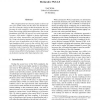Free Online Productivity Tools
i2Speak
i2Symbol
i2OCR
iTex2Img
iWeb2Print
iWeb2Shot
i2Type
iPdf2Split
iPdf2Merge
i2Bopomofo
i2Arabic
i2Style
i2Image
i2PDF
iLatex2Rtf
Sci2ools
IRI
2007
IEEE
2007
IEEE
Declarative Web 2.0
Web 2.0 applications have become popular as drivers of new types of Web content, but they have also introduced a new level of interface design in Web development; they are focusing on richer interfaces, user-generated content, and better interworking of Web-based applications. The current foundations of the Web 2.0, however, are strictly imperative in nature, which makes it difficult to develop applications which are robust, interoperable, and backwards compatible. Using a declarative approach for Web 2.0 applications, this new wave of applications can be built on a more robust foundation which is more in line with the Web’s style of using declarative methods whenever possible. We show a path how today’s imperative Web 2.0 applications can be regarded as a testbed as well as a first implementation for a revised version of Web 2.0 technologies, which will be based on declarative markup rather than imperative code.
| Added | 03 Jun 2010 |
| Updated | 03 Jun 2010 |
| Type | Conference |
| Year | 2007 |
| Where | IRI |
| Authors | Erik Wilde |
Comments (0)

